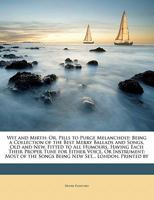Wit and Mirth or Pills to Purge Melancholy
Select Format
Select Condition 
Based on Your Recent Browsing
Book Overview
This work has been selected by scholars as being culturally important, and is part of the knowledge base of civilization as we know it.This work is in the "public domain in the United States of America, and possibly other nations. Within the United States, you may freely copy and distribute this work, as no entity (individual or corporate) has a copyright on the body of the work.Scholars believe, and we concur, that this work is important enough to be preserved, reproduced, and made generally available to the public. We appreciate your support of the preservation process, and thank you for being an important part of keeping this knowledge alive and relevant. This description may be from another edition of this product.
Format:Hardcover
Language:English
ISBN:1932033866
ISBN13:9781932033861
Release Date:September 2008
Publisher:Casemate
Length:448 Pages
Weight:1.93 lbs.
Dimensions:1.4" x 6.0" x 9.0"
More by Henry Playford
Customer Reviews
5 customer ratings | 5 reviews
There are currently no reviews. Be the first to review this work.












































